Sustainable Yellowtail: A Beautiful Thing
One of the best parts of my job is that I tend to get a lot of free food. Even food that I winds up on the set is still edible when I’m done. Oh, I wouldn’t go feeding it to guests or anything… afterall, it is usually cold and always has been poked and prodded by my fingers. But, it’s also made from the highest quality of ingredients I can find, and is (almost) always, delicious.
Most of the time, this free food is simply left over from a shoot that I’m doing. Sometimes, it’s sent to me by companies that are looking for feedback, really excited about sharing their product with someone who thinks a lot about food, or someone who is simply looking for extra press. I certainly understand that there are some bloggers out there who prefer not to accept free stuff… but I’m not one of them. When I get free stuff, I never promise to write about it on this blog. It takes something pretty special, in fact, to make it on here. And, sometimes, I still don’t even get around to it. But, sometimes, like today, I do.
Today, I want to share with you a fish that I am really excited about. When I got mail from Hannah asking if I’d be interested in trying some Kona Kampachi from Kona Blue, I was intrigued. I’m a huge fan of sushi, and will always have a hard time turning away from sashimi-grade yellowtail. But, what really struck me is that Kona Blue is a company trying new methods of fish farming that attempt to solve some of the problems of related to traditional “aquaculture.” In-shore fish farm can create serious pollution problems, releasing waste and excess nutrients into water at rates that can’t be cleaned up by natural processes. Those farmed fish also tend to suffer from mercury poisoning. Kona Blue is fishing in large sea-cages sunk into deep water far off shore, so the fish can basically school as they would in the wild and the pollution problems can be avoided. And, at the same time, the natural fish population is not being depleted. The fish also boast a 30 percent fat content, high levels of omega-3 fatty acids, and no detectable mercury.
I think it’s really early to tell whether these new fish farming practices are a good thing or if they introduce problems of their own. But, I applaud companies for trying to solve some of these problems in a responsible way. Plus, I can tell you this, the fish is beautiful.
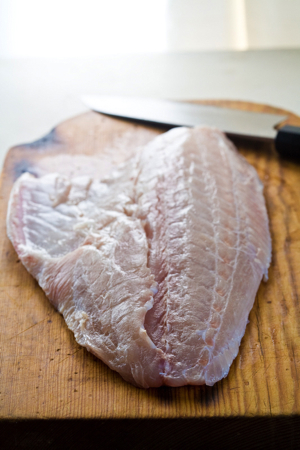
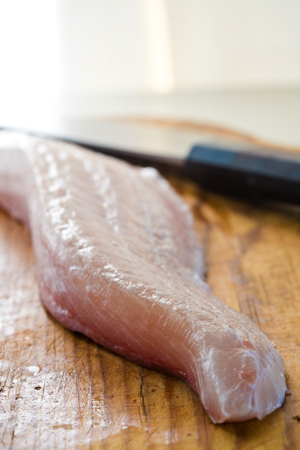
My package arrived well packed in ice, but not frozen, so the two, large fillets were immediately ready to use. The fillets are thick and fatty… perfect for a nice lunch of sashimi, with a ton still left over.
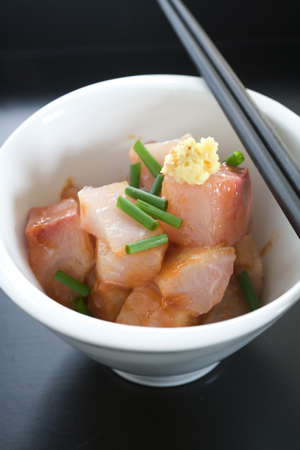
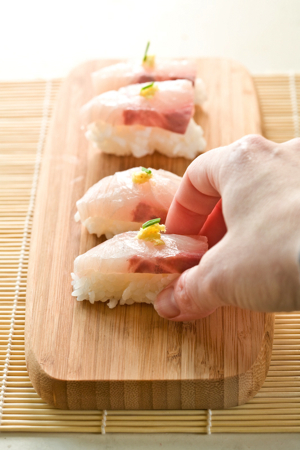
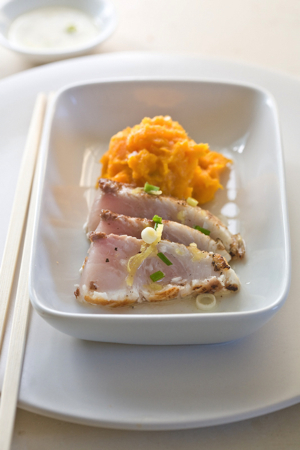
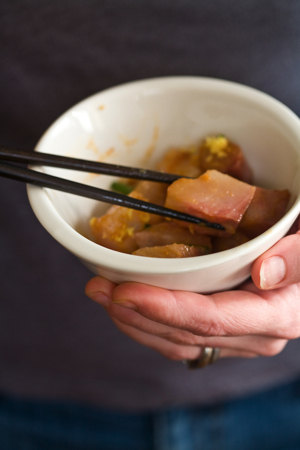
In fact I’ve been playing with a variety of preparations… the fish is so fresh, it’s almost a crime to cook it… but in addition to a sashimi miso salad, some simple nigiri sushi, I also lightly seared a good chunk and served it with a butternut squash mash and a fresh lemon dressing. Yum. I still have a whole fillet left that will have to be put to use quite soon. In the meantime, I thought I’d share a few shots and recipes with you.
If you want to try to find some of this fish on your own, you can order it from their website… but shipping is quite expensive. If you are in Seattle, Uwajimaya sometimes has it in stock and several area restaurants, like Canlis and Oceanaire have it on their menu. Or you can check out Kona Blue’s extensive “where to find” list.
PS: Thanks to Matt for correcting my initial mis-statement that Yellowtail is Tuna. In fact, it is its very own fish. All these years of ordering hamachi, and I always thought I was eating tuna!!!
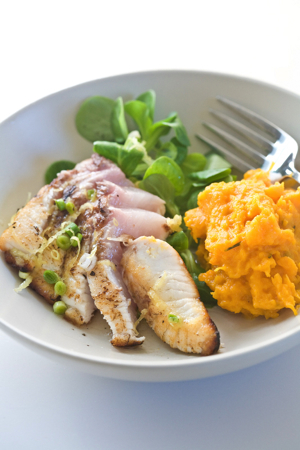
Seared Yellowtail in Lemon Dressing
From Arabesque by Claudia Roden
I went searching through about 15 different cookbooks to find this super simple seared tuna recipe. Most of the other recipes I found piled on enough seasonings that the flavor of the fish would be lost. This yellowtail was far to lovely to cover up. What loved about the Arabesque recipe was how delicate the dressing is… it brightens and enriches the flavors already in the fish. I substituted hazelnut oil in the dressing, which I thought brought even a new dimension to the flavor. The original recipe also recommended pairing the seared fish with mashed potatoes, but I had some left over roasted butternut squash that I smashed up with a little OJ and a little cream which went beautifully with the citrus sauce on the fish. A little mache salad on the side brings a little more springtime to the plate.
1 lemon
2 T hazelnut oil
salt & pepper
1 thinly chopped green onion (or fresh chives)
2 T olive oil
1 thick-cut fillet of sashimi grade yellowtail (or tuna)
Zest and juice the lemon into a small bowl. Add the hazelnut oil, green onion and freshly cracked pepper. Set aside.
Heat the olive oil in a pan on high heat. Just before the smoking point, add the fish. Sear for only 1 minute on each side. Remove from heat. Slice into thin slices and sprinkle with sea salt flakes. Pour the dressing over the top to serve.
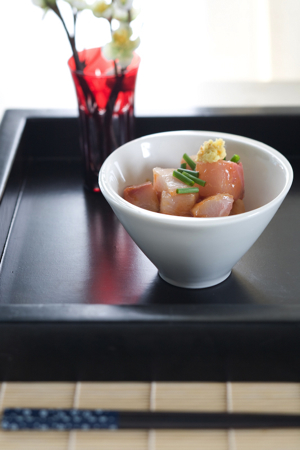
Yellowtail Sashimi in Miso Dressing
From Harumi’s Japanese Home Cooking
Here’s another lovely recipe from Harumi’s Japanese Home Cooking. This is so simple, but does require the best fish you can find, with a good amount of fat on it. The fat helps give a wonderful silky mouthfeel, not to mention a richer taste. You’ll need a few ingredients that you’ll probably have to go to an Asian market to get. Red miso paste and mirin can be hard to find in some supermarkets.
1/3 lb sashimi-quality yellowtail (or tuna)
3 T red miso paste
1 1/2 T casters (super-fine) sugar
1/2 T mirin
1 t rice vinegar
1/8 t dry mustard
1 1/2 c chopped green onion or chives
1 T finely grated ginger
Mix together the miso, suar, mirin, vinegar and mustard, until smooth and the sugar has dissolved.
Cut the fish into little cubes, about 1/2 to 1 inch each, and place in a medium sized bowl. Start adding the dressing a little at a time, stirring gently, until each piece is nicely coated. You may not need to use all the dressing… and I think it is best not to add too much dressing or you won’t taste the fish.
To serve, place in individual bowls, and top each with the green onion and a little dollop of freshly grated ginger.
Blimey, this is right up my street. Top job Lara. Great looking fish. With all the news recently about mercury in tuna, it is a great thing to find an alternative that looks like it is free of mercury. Tuna is such a healthy fish to eat, I am joyed to discover your post today!
The yellowtail looks very refreshing, I love the color that the side dishes add.
This looks so delicious, but a piece at Gourmet.com claims that Kona Blue faces similar problems as conventional fish: http://www.gourmet.com/foodpolitics/2008/01/politicsoftheplate_01_25_08
Wow. Makes me want fish for dinner!! Love what you did with it.
I recently got the same offer, can’t wait to receive this fish. I’m glad Uwajimaya carries it. 🙂
Gorgeous and free of toxins, sustainable… perfect!
Could you please share the bright orange purée’s recipe with us? I’m very curious about it 🙂
Looks great – good idea substituting the potato mash with butter nut. Some how it’s more right this time a year.
I for one am glad you decided to write about Kona Blue’s innovative idea(s) for sustainable fish farming. I love hearing news about companies who are making the effort to improve the quality of their food while reducing unwanted by-products, and will continue to watch this (mariculture) type of deep-sea fish farming to see if it can relieve some of the known issues of traditional aquaculture.
By the way, the fillets (and how you prepared them) look lovely!
I love yellowtail and these fotos show it to fabulous advantage. Poke on the food all you want; if I were there I’d happily eat it with you.
Hi, I was wondering if it would be ok if I link to you?
The seared tuna with squash looks divine. For some reason I haven’t been brave enough to attempt sushi at home. Beautiful site, I love the freshness of your images, very warm and welcoming.
that’s a beautiful piece of fish.
i don’t do the sushi/sashimi thing – i’ve never been able to – but this looks so amazingly refreshing that it makes me want to try again.
drooling. YUM!
how do you make fish look so graceful?
I love your recipes and your pictures !!! bravo !
Though I don’t know how sustainable the fish is, I know I can get sushi grade yellowtail in the Japantown which is two blocks from where I work. I’d love to try the Sashimi in Miso Dressing.
Your photos are lovely.
Hi, may I enquire, is yellowtail a fatty fish like salmon?
I’ve always wondered how sustainable these products really are. Salmon farming, in my mind, is just about the worst ag/aqua production that I know of. But, don’t these deep sea operations make it harder to detect the problem. These operations still are CAFOs, aren’t they? It would seem to me that all of that poop is just swept to sea by the deep ocen currents. Further, one of my biggest issues with salmon farming is that they are overfishing many parts of the world in order to feed the salmon, while a good part of the nutrients are lost when the fish are processed into fish food. Plus, much of that feed simply precipitates to the ocean floor because it can’t all be snapped up by the penned fish. Do they dose their fish with antibiotics and hormones as the salmon farmers allegedly do? Neuro-toxins? Colorings in the feed?
I’ve been particularly curious about these things…does anyone know? Because, I’ve sampled these products at food shows…and they are tasty…I’ve always been curious about integrating products like these into my businesses.
Thanks for your post…and the great photos!